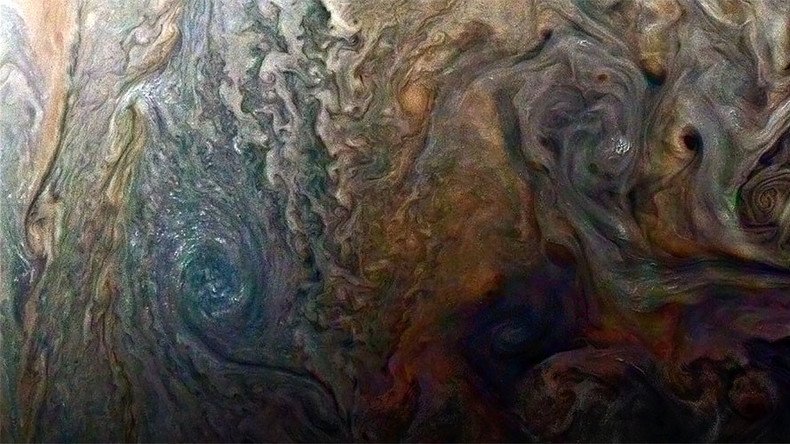‘Galaxy of swirling storms’: Juno snaps stunning turbulence over Jupiter (PHOTO)

NASA has released a fresh photograph of an intense storm swirling across Jupiter as space probe Juno prepares for its fifth flyby of the Solar System’s largest planet.
The picture was taken on February 2 as Juno flew 9,000 miles (14,500 kilometers) above the giant planet’s clouds. It was given the title “dark spot” due to the unusual black mark in the middle ground of the photo.
Researchers were initially unable to fully explain the spot, but after enhancing the image it became clear that it was a dark and swirling storm. Just below it sits a bright oval-shaped storm with white clouds.
READ MORE: Trump signs NASA funding bill to send astronauts to Mars
In a statement, NASA described the scene as “reminiscent of a swirling galaxy.” Juno will aim to take further pictures of Jupiter’s turbulent weather fronts as it undergoes its fifth flyby of the planet Monday.
As the space probe flies over the planet's thick cloud, the craft’s tiny four-color “JunoCam” will be trained on at least 10 points of interest. JunoCam will also take snapshots of Jupiter’s North Pole and South Pole, about which not much is known.
#Jupiter cloudscape. This close-up #JunoCam view captures the turbulent region just west of the Great Red Spot https://t.co/kOBoBQmumPpic.twitter.com/tlymIbVfhQ
— NASA's Juno Mission (@NASAJuno) March 1, 2017
At its closest, Juno will fly about 2,700 miles (4,400 kilometers) above the planet's cloud tops, traveling at a speed of about 129,000 miles per hour.
"This will be our fourth science pass – the fifth close flyby of Jupiter of the mission – and we are excited to see what new discoveries Juno will reveal," Scott Bolton, principal investigator of Juno from the Southwest Research Institute said. “Every time we get near Jupiter’s cloud tops, we learn new insights that help us understand this amazing giant planet."
#Jupiter ahead! I’ll make my next flyby over the planet’s mysterious cloud tops on March 27 at 1:52am PT https://t.co/8F6CesOVtapic.twitter.com/H15U0SWaq1
— NASA's Juno Mission (@NASAJuno) March 24, 2017
NASA scientists continue to analyze information gathered in previous flybys. They have already learned that Jupiter's magnetic fields are more complicated than originally thought, and that the belts that give the planet's cloud tops their distinctive look extend deep into its interior.
More in-depth results are expected to be published in peer-reviewed papers within the next few months.












